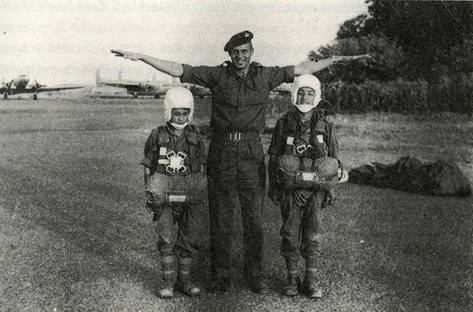China (target: Tibet) 1958-74

T.J. Thompson (Air America) with two Tibetan student parachute riggers in India
For centuries, the Chinese had claimed Tibet as their own, and although turmoil in China meant that this claim was unable to be enforced for several decades, the Communists' triumph in the civil war put an end to this state of grace. In 1950, China invaded Tibet , following up its military victory with a political agreement that ended anything resembling Tibetan independence. At that point, a flurry of exchanges took place between Tibet 's leader, the Dalai Lama, and U.S. officials, with the possibility being raised of American military aid to any Tibetan resistance groups. Nothing came of this for the moment and the Dalai Lama returned to his capital. Then, in 1956, rebellions broke out in the north and east of Tibet , the Dalai Lama's brother contacted the U.S. , and, in order to get more information on the uprisings, the CIA arranged to train a small number of exiles in guerrilla tactics and radio communications techniques. They were parachuted back into Tibet in 1957, during which time the insurgency had been growing in strength. By 1958, the rebels had linked up and, in the face of stiff Chinese offensives, were calling for weapons and ammunition, something which the CIA agreed to provide in air drops using weapons and planes left over from operations in Indonesia (see the writeup on this website) and elsewhere in China . In addition, the CIA began training additional exiles, this time in Colorado , whose altitude and climate was thought to resemble that of Tibet .
However, the air drops and training had barely gotten under way when the fighting in Tibet reached its height. Over several months in early 1959, the rebels launched large-scale attacks on Chinese forces and then suffered massive counterattacks, which “pretty well knocked to pieces” the resistance. A stream of refugees now poured into India , among them the Dalai Lama himself. Washington thus found itself with a feeble and scattered internal resistance but a large number of potential external recruits. Training therefore continued: the exiles were instructed, transported back to Tibet , and dropped, along with supplies, in areas thought to harbor small numbers of rebels. (There was also one Kuomintang-supported raid against the road linking Tibet with neighboring Chinese provinces.) While these operations were going on, another group of exiles approached the CIA and received encouragement to form camps (supplied by U.S. air drops) in Nepal , just over the border from Tibet . Neither of these efforts were “especially productive”: the airborne raiders were usually isolated, killed by the Chinese, or compelled to run for India ; the land raiders spent most of their time in camp.
In spite of these failures, the Tibet program not only continued but expanded. Whenever it was criticized for military ineffectiveness, a new goal was found that was, in effect, stapled to the policy instrument, thereby giving the latter a new lease on life. For example, one U.S. ambassador to India scathingly described the raids as a “particularly insane enterprise,” only to reverse course the next year, after the Sino-Indian border skirmishes led the U.S. and India to set up a third armed force of Tibetan exiles. (This group, which was under Indian control, also did little, seeing its most significant combat not in Tibet but against Pakistan in the 1971 war.) By early 1964, a highly elastic goal had been found for the raids: “to keep the political concept of an autonomous Tibet alive within Tibet and among foreign nations, principally India , and to build a capacity for resistance against possible political developments inside Communist China.” On this Micawber-like logic (“something will turn up”), the CIA's STCIRCUS exile programs continued until the early 1970s, when a combination of organizational fatigue in Washington, declining physical capacity among the now-middle aged fighters, opposition by the Nepalese government, and a general sense that both the situation in Tibet and U.S. relations with China had changed put an end to them. 1
1) Allen Dulles in National Security Council meeting, 23 April 1959, FRUS 1958-1960 , vol. 19: doc. 371; also docs. 279, 367-9, 373, 375, 378-80, 400; Colby in Special Group meeting, 19 September 1963, FRUS 1961-1963 , vol. 22: doc. 189; also docs. 79, 155; Galbraith quoted in Knaus (1999: 245); Memorandum for the Special Group, 9 January 1964, FRUS 1964-1968 , vol. 30: doc. 337; also doc. 342 (with a chronology of approvals); FRUS 1969-1976 , vol. 17: docs. 273-4, 278, 280; Prados (1996: ch. 9); Knaus (1999; 2003); Conboy and Morrison (2002); Garver (2004). The FRUS volumes contain only a handful of documents pertaining to STCIRCUS, several of which have been so extensively “sanitized” as to render them close to useless. An even more recent example of means-centered policy making is the conversion by the Indians of “their” Tibetans into an anti-terrorist unit (Conboy and Morrison 2002: 258).
